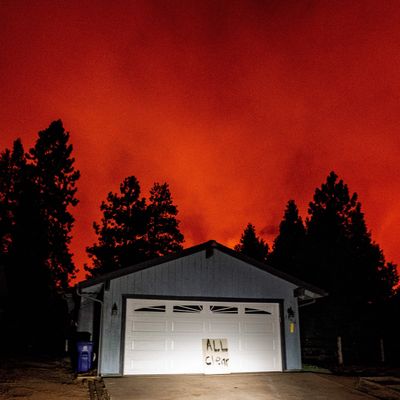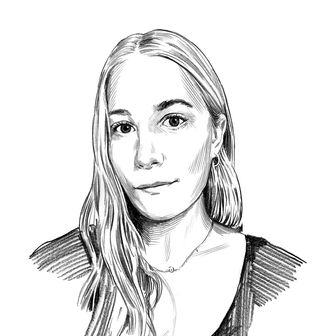
Once again, the American West is engulfed in the thick smoke of yet another historically devastating fire season. There are active blazes in Utah, Nevada, Arizona, Idaho, Oregon, Wyoming, Washington, and Montana. Smoke, visible from space in giant, voluminous plumes, has floated as far east as Alabama. In California, 2 million acres have already burned, displacing more than 200,000 people and killing ten — and the dry season has yet to peak.
In my part of the state, to the south, the sky is a dirty yellow-gray. The air has a kind of sourness, and a heaviness, that can worsen as the day goes on, depending on how much smoke this year’s Santa Ana winds have pulled over from the closest fire. In the Bay Area, where at least three massive fires are still burning, the sky has turned bright, chemical orange, and the sun has been setting a cauterizing red. Rolling blackouts have shut off power for hundreds of thousands, leaving people in the dark with temperatures over 100 degrees.
As California burns, hellish footage is circulating on social media: a hiker surrounded by hills erupting in orange flames, the ground behind him cracked and smoldering, coughing on his words; the sky in San Francisco a thick, sickly orange for at least the seventh day in a row; a sign in front of a senior center in Napa County that says “stay safe,” surrounded by explosive, volcanic flames.
Things are very bad and getting worse. That much is clear. For years, scientists have predicted we’d face more severe fire seasons in hotter, drier conditions because of climate change. Now, these nightmare scenarios, what they call “compound climate events,” are becoming annual. But what is somehow more terrifying than their escalation is how quickly we seem to be adapting to them.
Apocalyptic fire footage goes viral with each season. Now there’s another genre of images that’s disturbing for the opposite reason: These photos show how quickly people have learned to adjust to life in an inferno. A man relaxes in his folding chair on the shore of a lake, fire lighting up the red sky. Little league baseball teams play under a towering cloud of gray smoke like a tornado. Last year, amid fires that were record-breaking at the time, a couple posed for their wedding photos in front of a bright-orange vista of flames, both of them in masks to protect against the smoke. (This was pre-COVID, before we all grew accustomed to the image of a masked bride and groom.)
California burns, life goes on, and individuals are left to take care of themselves and their families against the apocalyptic backdrop. What else can they do? Politicians react incrementally, if at all; extreme weather, not to mention the climate crisis, gets a fraction of news coverage. Even California just approved a heavily criticized plan to cut power-plant emissions by only 25 percent over the next decade, a rate slower than they fell in the previous one. Absent meaningful government intervention and institutional alarm, the red-flag warnings, evacuations, helicopter rescues, blackouts, and nasty, stinging air become routine. People document the burnt skies and sunsets, but the images just gather in their own kind of cloud.
As recommended by the governor, I have downloaded my “Ready for Wildfire” app. It sends me push notifications asking things like, “Do you have your wildfire evacuation plan ready?” Sure I do. But it feels woefully inadequate, and, moreover, the question itself is tragically small. All around, the crises of our era feel increasingly connected; in perhaps the most emblematic of 2020 developments, incarcerated California state prisoners who used to battle fires for less than $5 a day are too sick with coronavirus to put them out. The evidence is mounting that we are indeed reaching a tipping point on our warming planet, one that can only be met with sweeping action on a massive scale, by expanding our collective imaginations and willpower. Yet we continue to be encouraged to take individual actions to solve the problem. The survival strategy shrinks to each person, masked-up, car parked facing out in the driveway, go-bag in the trunk. But where will we go?


